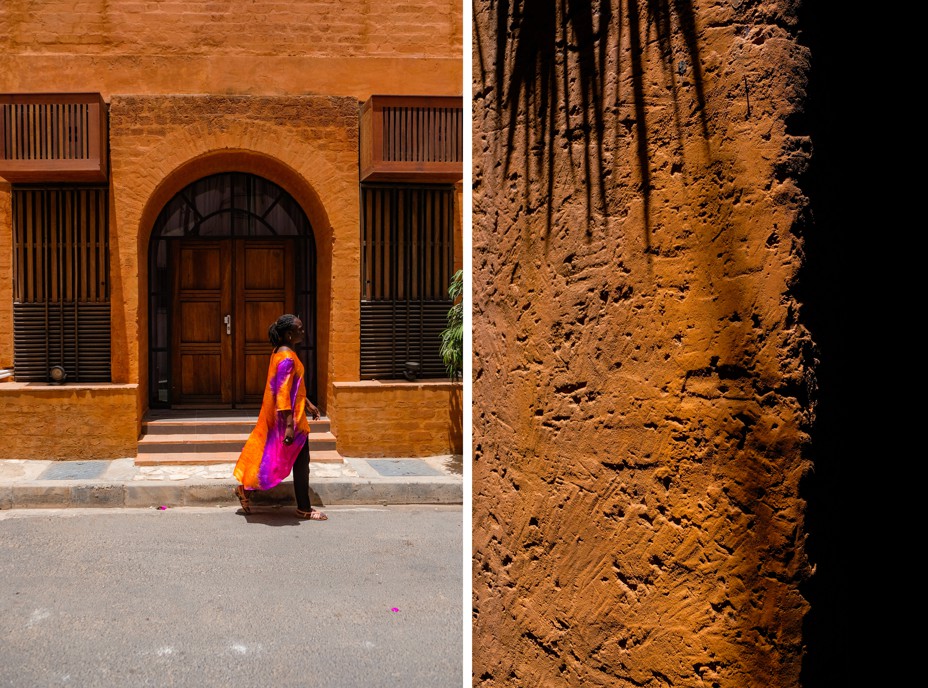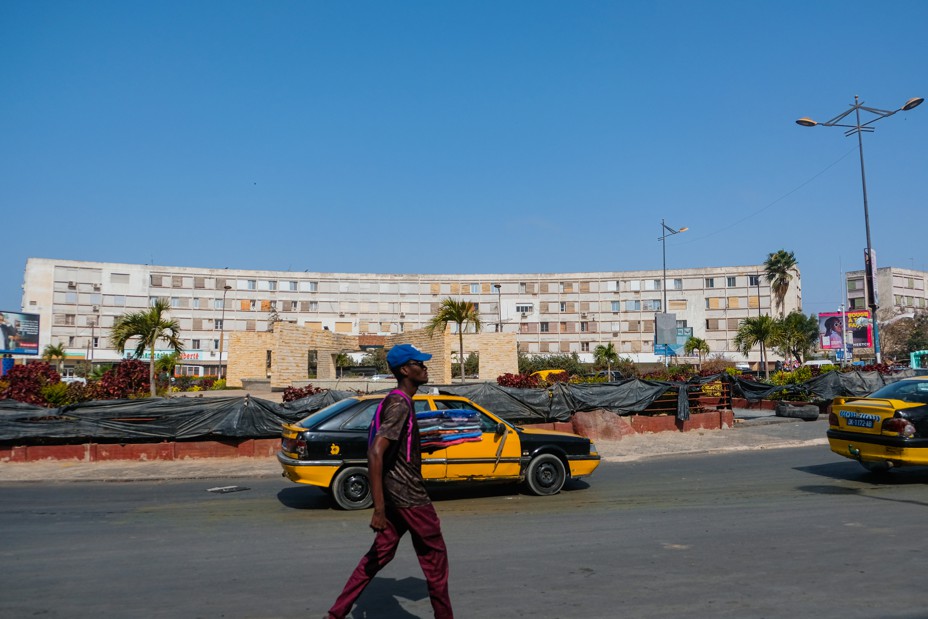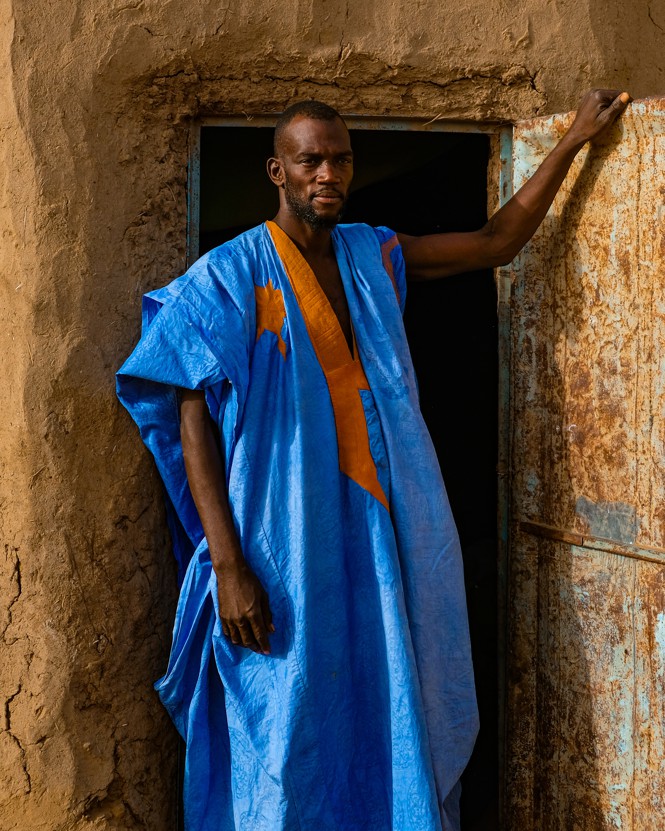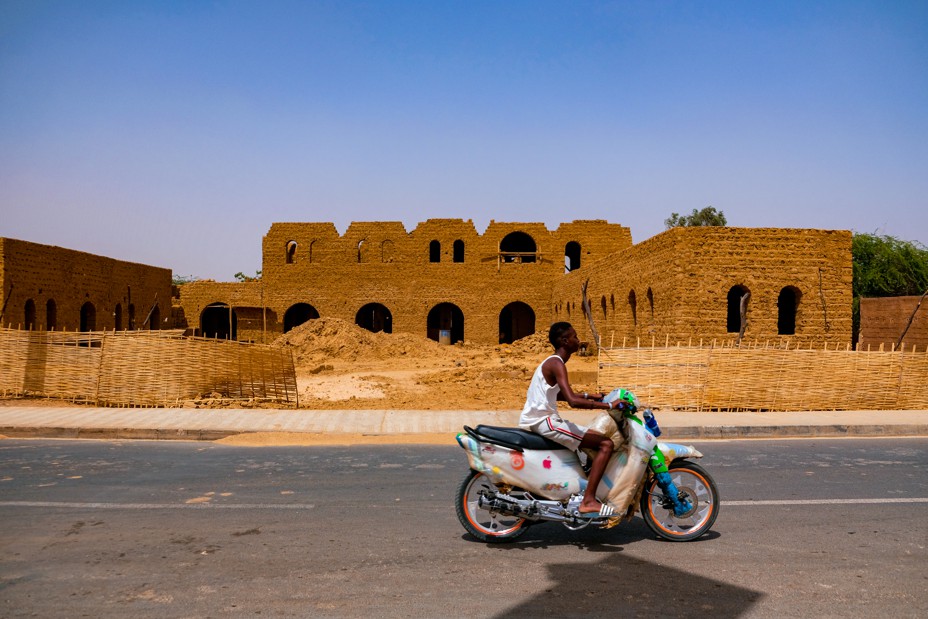
When Germany’s president, Frank-Walter Steinmeier, came to Senegal last February for an economic summit, he took a break from conference rooms in the capital city of Dakar to get his hands dirty, literally, as he learned to make compressed-earth blocks from a mix of iron-rich soil, sand, water, and a bit of cement. His block-making tutorial was part of a groundbreaking event for a cultural institute promoting German-language study. The institute’s new building was designed by the distinguished Burkina Faso–born and Berlin-based architect Francis Kéré, who is renowned worldwide for his graceful structures adapted to their local climates. The building in Dakar is oriented so that nearby trees provide shade, and its thick walls—made of the type of unfired compressed-earth bricks Steinmeier tried his hand at making—insulate the interior from the hot Senegalese climate. A layer of claustras, or perforated walls, wraps around the building like a membrane, filtering sunlight and directing airflow.
At the event, Senegal’s minister of urbanism, Abdoulaye Saydou Sow, praised Kéré’s choice of materials, promising that the government would “work to integrate these types of materials into our building projects.”
The Senegalese-Cameroonian architect Nzinga Mboup, 33, was in the crowd for the occasion, her bronze dress shining amid the sea of dark suits, and she was thrilled by the minister’s speech. Mboup, a co-founder of a Senegalese architectural firm called Worofila, is working with Kéré on his Dakar project. Her firm also works with the local climate, often borrowing low-tech, passive cooling techniques from West African vernacular building traditions. Such simple strategies may not sound revolutionary, but in Senegal’s cities, they are.
Today, Dakar is primarily a city of boxy, concrete buildings, their flat roofs used for hanging laundry, lodging sheep, or both. And new boxes are always sprouting: A panorama of gray-walled construction sites is visible from any balcony, and city sidewalks are chronically clogged with rebar, bags of cement, and piles of sand and gravel. Concrete’s heat-retaining properties are all wrong for the Senegalese climate, which will continue to get hotter over the next few decades according to climate-change models. Yet concrete has become the “traditional” building material in a country where, as Mboup points out, at least four distinctive mud-construction techniques persist. In the north, where there’s not much rain, people build houses with banco, a kind of adobe made with sun-dried bricks; in the forested areas of the south, builders use timber frames to create wattle-and-daub structures, or they hand-mold earthen buildings and top them with steep, overhanging roofs to keep rain away from the walls. For generations, Senegalese builders have used mud to construct not only small houses and granaries but multistory houses and imposing mosques.
I first met Mboup in the rooftop café of the Djoloff Hotel, a building that breaks from Dakar’s concrete-box tradition. The hotel’s high ceilings, gracious courtyards, and bougainvillea-covered verandas are characteristic of the French colonial style, but nearly half of the building is constructed from unfired mud bricks, and their ocher splendor contrasts sharply with the city’s gray palette. Mboup and her co-founder, Nicolas Rondet, often meet people here; Worofila had nothing to do with the building’s design, but the firm’s office is located not far away in the same quiet neighborhood, and to Mboup and Rondet, the elegant hotel demonstrates the potential of modern mud building. As Mboup and I talked about the bricks she often uses in her design, she sometimes reached out to touch one in situ.

When Mboup tells new acquaintances in Senegal that she’s an architect who specializes in mud construction, they’re always surprised. “They say, ‘How can you build with mud? Mud doesn’t last,’” she says. They may be remembering horror stories about mud houses leaking when the seasonal rains start, and sometimes even dissolving or crumbling in torrential downpours. They often think concrete is easier to use and a safer investment—though poorly built concrete buildings have also crumbled during past monsoon seasons.
In general, concrete buildings are more resistant to rain than many kinds of earthen structures, especially those that aren’t protected with a high foundation and a good roof. And they do require less maintenance than some mud buildings, which need to be replastered regularly to maintain their structural integrity. But concrete carries its own costs. “People build houses in concrete,” Mboup says, “and then they can’t sleep at night because it’s too hot.”
Raw-earth-based building materials, such as adobe, rammed earth, and the compressed-earth blocks used in the Djoloff and Kéré buildings, have more thermal inertia than concrete, which means they attenuate heat and cold more efficiently and reduce the need for so much air-conditioning. These materials, along with greater attention to building orientation, help reduce energy use when demand is highest.
[Read: The future of architecture: moss, not mirrors]
But resistance to mud construction in modern Senegal goes beyond practical concerns: Earth-based materials are widely considered a symbol of poverty, a last recourse for those with no other shelter. The Senegalese architect and professor Mamadou Jean-Charles Tall has spent much of his career of 40-plus years battling this stereotype. In the early 1980s, when he returned to Senegal after studying architecture in Marseille and began telling acquaintances that he was going to build with earth instead of cement, “they would look at you as if you had just flown in from Mars,” he remembers. Tall often gets the same reaction from clients today. “In the minds of Senegalese people, and I think a lot of other Africans too, building with mud is like going back to the village,” he says.

The urban geographer Eric Ross, a professor at Al Akhawayn University, in Morocco, who studies the development of Senegal’s cities, says the denigration of mud as a building material followed the rise of concrete during the post-colonial period of the 1960s and ’70s. At that time, African countries were shaping new identities, rewriting their agrarian pasts, and embracing everything associated with modernity. “It was like nation-building, physically, was with cement,” Ross says. Concrete buildings mushroomed in independent Senegal: hotels and apartment buildings, novel structures shaped like triangles and polygons, brutalist skyscrapers made of angular bits of concrete and glass. Concrete began to be used in single-family villas and bungalows, too, and it soon overwhelmed the building market.
Cement is easy to get—at least in Senegal, which has three cement factories—and now, Tall says, most local contractors and masons only know how to use cement and make concrete. “So many problems arise on [earth-based] construction sites, simply because some workers did not know how to work with mud at all,” he says.
Tall adds that the accessibility of air-conditioning has created a kind of architectural laziness, because buildings no longer need to rely on design to stay cool. Along one of Dakar’s main thoroughfares, he points out, all the big office buildings are oriented toward the west, with large windows that are exposed to full sun from noon to sunset. “But no one minds because they think they can put the air-conditioning on, so whatever,” he says. The businesses do mind their outsized electricity bills, though, which are swelling even more as temperatures increase.
The Worofila co-founder Nicolas Rondet, who, like Mboup, is 33, grew up in France and was motivated by his concern about climate change to study the low-tech, energy-efficient building designs once common across Europe, Asia, and Africa. As a young professional architect in Paris, he found little support. “In my personal experience, nearly everyone just wanted to do conventional construction—an insulated concrete building the same as usual, and then put solar panels on the roof and call it a green building,” he says. “But nothing substantive, no overall thinking about what it is to build ecologically.”
He decided to look for a place where such techniques were still in use so that he could incorporate them into his designs. When Rondet’s wife, who is also an architect, was offered a position working on a historical renovation project in Dakar, Rondet felt he had found a place to begin.

Although Dakar and most of Senegal’s coastal cities are dense monuments to concrete, there are areas of Senegal where vernacular building traditions endure. During the eight-hour drive inland from Dakar to the northern town of Podor, the blacktop road crosses an ocean of crunchy sand. Near the coast, the villages are dominated by cement-block houses—mostly multistory at first, then predominantly single-story. As the road continues north and east, houses made of reeds and hay appear, followed by others built from rusty-red banco.
Podor sits on a ridge above the Senegal River, not far from the southern edge of the Sahara. For centuries, residents have built houses that have let them cope with the harsh environment. When I visited in February, the day was hot, nearly 100 degrees, and the sky was full of dust. Temperatures regularly approach 110 degrees in Podor, and can close in on 120 degrees from April to June. By contrast, the temperature at Senegal’s international airport, which is closer to Dakar and not far from the coast, was a perfect 75 degrees on the day I visited Podor. Climate-change models predict that coastal Senegal’s weather could start to feel like the interior of the county by the end of this century, so Dakar may need to turn to Podor for inspiration.
In the nearby village of Ngawlé, Ousmane Mbodj and his family invited me into their banco house, and as soon as I stepped inside, my body relaxed. I had no instruments to measure the difference in temperature, but the change felt like a balm.
Mbodj built this house for his family in 2006. “We took all the banco just from here in the courtyard,” he said. Most of the houses in the village, he added, were built in the same way. Their thick walls provide natural insulation from the sun, while the limited number of small windows helps the interior stay cool. Outside, thatch-covered verandas or perforated walls create shade and can be used as exterior rooms. For Mbodj and many of his neighbors, building with banco is a tradition that dates back generations.
But even Mbodj says he would like to build en dur, in cement, if he ever gets a chance. For one, his roof leaks during the rainy season because the local mice like to eat its mud and hay, a problem he’s spent many years trying to solve. But a cement house, he suggests, is also prestigious—a way to show off one’s financial success. Mud may be the local tradition, but it’s also what you do when you’re poor and don’t have any other options.

In the center of Podor, the local département is constructing a mud-brick administrative building using the Nubian-vault technique. Originating from ancient Egypt, the method uses arches to create self-supporting adobe structures. The technique was revived in the 1940s by the Egyptian architect Hassan Fathy, who attempted to create a whole village of Nubian-vault structures on the banks of the Nile River. That project was never completed, but his approach, which he documented in his book Architecture for the Poor, created new interest in mud construction across the globe. In 2000, a French nonprofit called the Nubian Vault Association streamlined the technique and started training workers to employ it throughout West Africa—starting in Burkina Faso and expanding to Mali, Benin, Ghana, and Senegal.
[Read: How Earth was a very different place before mud]
In Podor, the masons work quickly to place the bricks before the mortar—which is also made from mud—dries; in some places, the walls are more than two and a half feet thick. Malick Sy, the project’s coordinator, told me that the building was financed by French donors: “External demand is strong. But the local interest is limited. People still have a complex about it.” The local ideal, Sy said, remains a modern concrete building with a shiny zinc roof. But he hopes that this beautiful public building might persuade the public to reconsider the advantages of mud over concrete.
Even as northerners continue to favor concrete over banco, an earth-construction boom is happening along the sunny coast south of Dakar. Here, earth construction is chosen not just by those with modest budgets and few other options, but by wealthier families with a taste for innovation and bespoke designs.
On the way to a construction site outside Dakar, Nzinga Mboup got lost a few times. To be fair, her only guide was a pin on an unreliable online map. The roads were alternately pockmarked with tire-busting potholes, full of sinking sand, or blocked by troupes of wandering Zebu cows. Not for the first time or the last, she wished that more of her firm’s projects lay within Dakar’s city limits. Even though most of Worofila’s clients are well-heeled families, few of them can afford to build homes in the capital city. Dakar is densifying; the single-family bungalows that dotted the city’s center are being replaced by multistory apartment and office buildings, each higher than the last.
Worofila is working on one private home in Dakar, a luxurious five-story house constructed mostly from compressed-earth blocks. An atrium facilitates ventilation; soaring ceilings and high, narrow windows suffuse the living room with filtered light. Rondet, who showed me around the site, says they had planned to build nearly 12-inch-thick walls for their thermal advantages, but the small lot could only accommodate 9-inch-thick walls. To make up for the difference, they positioned each row of blocks so that it protruded slightly over the row below it, resulting in walls that essentially create their own shade. The walls’ textured surface gives them a unique appearance—a style inspired by substance. Though houses like this are far too expensive for most, Rondet argues that it illustrates both the practical and aesthetic advantages of mud construction.
In 2021, Worofila participated in the Royal Academy of Arts Summer Exhibition in London, an event designed to showcase the latest and best in contemporary art and design. The firm contributed one of the clay-and-Typha blocks it uses to insulate roofs, along with a brief description of one of Mboup’s recent projects: a modernized take on the traditional extended-family compound. In her reinterpretation, four separate structures—two made from concrete and two made from mud—are connected by courtyards and gardens.
Later in the year, Worofila also took over one of the Royal Academy’s Instagram accounts, sharing photos of the firm’s work and research. In an Instagram Live broadcast, Mboup noted that while a lot of people like the look of vernacular architecture, they don’t understand that the forms reflect many different considerations, from the surrounding climate and landscape to cultural and religious sensibilities. With its materials and approach, Mboup asserted, Worofila is trying to create “a form of new vernacular architecture.” If that sounds a bit grandiose, it’s because it is—a grand plan for a changing world.
Mboup did not grow up knowing Senegal’s vernacular building traditions. She was born in Mozambique to a Cameroonian lawyer mother and a Senegalese ambassador father who was also a trained anthropologist; she grew up mostly in South Africa. After finishing her graduate studies in architecture at the University of Westminster in London, Mboup got a job working with the Ghanaian British architect David Adjaye, who’s best known in the United States for designing the striking bronze-encased building that houses the Smithsonian Institution’s National Museum of African American History and Culture. An Adjaye project in Senegal—an energy-efficient building for the International Finance Corporation—brought Mboup to Dakar and changed the trajectory of her career. Though the building’s main support was concrete, the facade was to be made with compressed-earth bricks. While searching for materials to build the facade, she met Doudou Dème, a trained engineer and builder and the founder of Elementerre, a firm that specializes in the production of earth-building materials. Through Dème, she met other like-minded architects who wanted to work with local materials and build structures that would use less energy—and voilà, Worofila was born, first as a loose collective named for the street address of their shared workspace, then formalized as a firm.
No sign marks the Elementerre production site, which is located about an hour’s drive south of Dakar, but the red dirt trailing from behind a closed gate hints at its location. On the day I visited, about 20 workers were busy on the site. Some shoveled red dirt from a big pile, others passed it through a filter that picked out the larger stones, and two teams minded the brick presses. It takes five people to run a press: one person to fill the molds, two to pull the levers, one to remove the molds once the bricks are pressed, and one to stack the new bricks. Dème specifically chose machines that could be operated manually, without electricity or fuel. “You can use them anywhere,” he told me. “All you need is water and space.”
Dème, who is about 40 but looks a decade younger, said that almost all of his projects use compressed-earth blocks—including the Hôtel Le Djoloff expansion, which he built, and the Kéré project, where he is the builder.
When Dème started Elementerre in 2010, it was one of the only companies in Senegal working with unfired earth bricks, but others are following its lead. Mariama Djambony Badji and her business partner Papa Mafall Diop, both in their early 20s, are just finishing up their studies in civil engineering, but they’ve already launched a company that specializes in building with earth. Badji says she fell in love with the idea after attending a seminar on the subject at her university a few years ago. She learned about the techniques that some relatives in southern Senegal employed to build with mud, traveled across Senegal and Mali to learn about earth-building traditions, and studied with Doudou Dème’s team at Elementerre to learn how they were modernizing the old methods. When she meets clients, she says, they always ask the same questions about mud construction, beginning with “Is it strong and durable?” Like Elementerre, her firm offers semi-industrial compressed-earth blocks, which include a small amount of cement—an option that she says helps some clients feel more comfortable with mud.
The Elementerre client Isabelle Hourchani, an artisan in her mid-50s, is building a house in a town on the coast. She says her husband was skeptical when she brought up the idea of building with earth: “He thought it might collapse.” But he was persuaded by Dème’s careful approach and by Hourchani’s commitment. “I wanted to work with simple materials, ones that breathe,” she says. Most of all, she wanted a house that would stay cool in the heat, since she dislikes air-conditioning.

Fatoumata Bathily, a Senegalese American who works for the U.S. government in Senegal and Mali, says that after her husband saw Dème’s work on Hôtel Le Djoloff, they hired him to build their new house with compressed-earth blocks. “It was not so much the earth aspect of it; it was more like the aesthetic,” she says. “But then we found out more about it, and realized it is not only aesthetically pleasing but it also has more benefits.”
In addition to compressed-earth blocks, Elementerre makes prefabricated slabs and panels from mud and Typha, an invasive water reed that grows aggressively in some of Senegal’s freshwater bodies and clogs the flow of rivers and canals. These slabs, which are more insulating than compressed blocks, can be used in the construction of roofs, floors, and walls, and can even be installed in standard concrete buildings to reduce solar gain. Dème also plans to commercialize his “improved” versions of traditional mud bricks, like the banco used in northern Senegal. “We have just refined the formulation to make sure that we have a brick that is strong enough and will not buckle,” he told me. “We take the clay and add Typha, which we grind together with the soil and dry it.” These bricks insulate better than the compressed blocks, since they don’t contain any cement, and Dème noted that they can always be used again. Even if one day you knock down such a building, the bricks can have a new life, instead of being carted off to a landfill like concrete. “It’s totally renewable. You add water to it and make mud again,” he said. “It’s a complete loop.”
At the end of our walk-through of his production site, Dème told me that he is ready for a new type of challenge: one that will bring earth-based housing and all its benefits to more people. “I have done lots of buildings for people who have money, beautiful buildings, and it was very exciting for us,” he said. “That’s what made us credible. But I think the next step is to build housing developments to show people that we can build with local materials that will be much more comfortable and much cheaper than concrete.”
Dème is partnering with Rondet on the project, with some design input from Mboup. Over the next five years, with the backing of private investors, they plan to build a neighborhood of 200 homes near Thiès, one of Senegal’s largest cities. The neighborhood will include a road network, a power grid, and a sewer system that can filter wastewater—no small advantage in a country with chronic water shortages—and the purchase price of its homes will be close to the government standard for affordable housing. According to Rondet, it will be “an incremental neighborhood” that can grow and evolve with its inhabitants. “If I need more space, I can expand my house,” says Rondet. “It’s part of the project’s framework—it’s not something where you have to knock down the house and start again.” Another critical element is a training center for earth building, designed to produce the skilled workers that Dème and Rondet will need for such a large project. Dème is optimistic that the newly trained workers will have many opportunities to look forward to; if all goes well in Thiès, he plans to bring similar housing developments to several other cities across the country, adapting the design and materials of each development to its regional particularities.
“We have to do it; we have to show them,” says Dème. Only by demonstrating the potential of mud architecture in Senegal, he says, will he and his colleagues be able to scale their approach and take it to the people. Or, rather, take it back to the people—if they will accept it.
This Atlantic Planet story was supported by the HHMI Department of Science Education.







